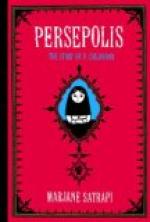I can understand better the mystery of that Divine Childhood that was once in the world, when I hear how these poor slaves, unasked, gave of their dying strength to this child; how, in tribes through which no white man had ever travelled alive, it was passed from one savage mother to the other, tenderly handled, nursed at their breasts; how a gentler, kindlier spirit seemed to come from the presence of the baby and its mother to the crew; so that, while at first they had cursed and fought their way along, they grew at the last helpful and tender with each other, often going back, when to go back was death, for the comrade who dropped by the way, and bringing him on until they too lay down, and were at rest together.
It was through the baby that deliverance came to them at last. The story that a white woman and a beautiful child had been wandering all winter through the deadly swamps was carried from one tribe to another until it reached the Spanish fort at St. Augustine. One day therefore, when near their last extremity, they “saw a Perre-augoe approaching by sea filled with soldiers, bearing a letter signifying the governor of St. Augustine’s great Care for our Preservation, of what Nation soever we were.” The journey, however, had to be made on foot; and it was more than two weeks before Dickenson, the old man, Mary and the child, and the last of the crew, reached St. Augustine.
“We came thereto,” he says, “about two hours before Night, and were directed to the governor’s house, where we were led up a pair of stairs, at the Head whereof stood the governor, who ordered my Wife to be conducted to his Wife’s Apartment.”
There is something in the picture of poor Mary, after her months of starvation and nakedness, coming into a lady’s chamber again, “where was a Fire and Bath and Cloathes,” which has a curious pathos in it to a woman.
Robert Barrow and Dickenson were given clothes, and a plentiful supper set before them.
St. Augustine was then a collection of a few old houses grouped about the fort; only a garrison, in fact, half supported by the king of Spain and half by the Church of Rome. Its three hundred male inhabitants were either soldiers or priests, dependent for supplies of money, clothing, or bread upon Havana; and as the famine had lasted for two years, and it was then three since a vessel had reached them from any place whatever, their poverty was extreme. They were all, too, the “false Catholicks and hireling Priests” whom, beyond all others, Dickenson distrusted and hated. Yet the grim Quaker’s hand seems to tremble as he writes down the record of their exceeding kindness; of how they welcomed them, looking, as they did, like naked furious beasts, and cared for them as if they were their brothers. The governor of the fort clothed the crew warmly, and out of his own great penury fed them abundantly. He was a reserved and silent man, with a grave courtesy and an odd gentle care for the woman and child that make him quite real to us. Dickenson does not even give his name. Yet it is worth much to us to know that a brother of us all lived on that solitary Florida coast two centuries ago, whether he was pagan, Protestant, or priest.




